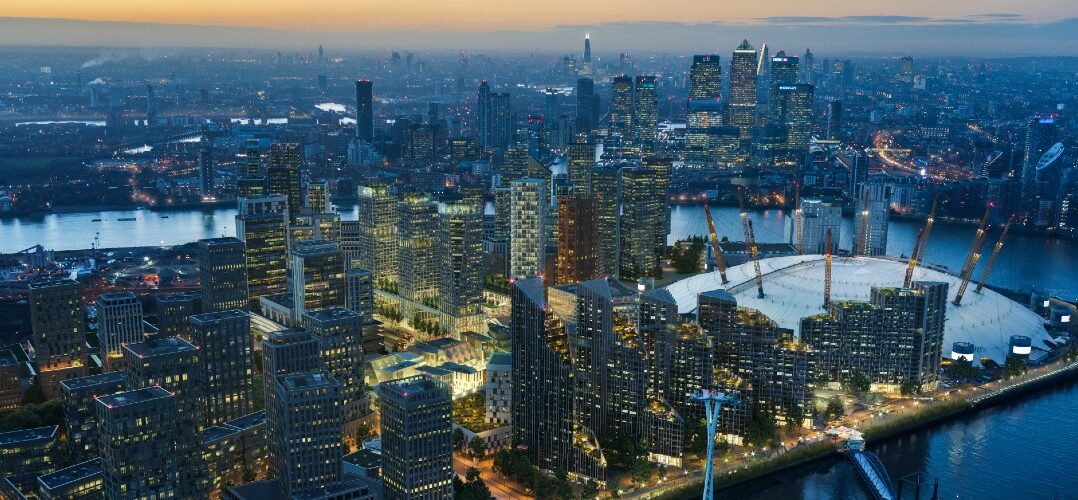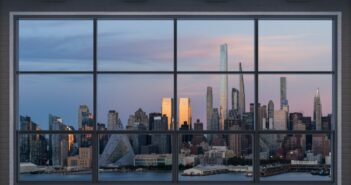The urban regeneration of Greenwich Peninsula is big – big enough to hold its own against the skyscrapers of Canary Wharf, on the other side of the Thames.
A former industrial site, Greenwich Peninsula, once known for its skyline of gasworks, is set to become home for 40,000 people over the next 20 years. It is also emerging as a destination to visit (currently at over three million a year), and a place to work and grow a business – especially for those in the creative industries.

Maintaining the Value of Your Real Estate in the Post-Pandemic World
Some 5,000 residents have already moved into the two out of seven neighbourhoods already completed (Upper Riverside and Lower Riverside), while this September sees the official opening of the Design District – an ‘ecosystem’ for London’s creative community.
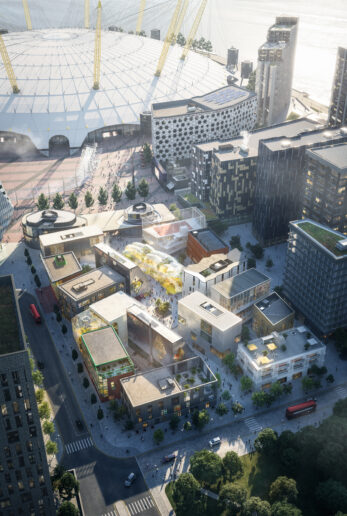
The Design District is across Peninsula Square from the 02 – the world’s busiest entertainment arena
Design, together with arts & culture, is at the heart of the £8.4bn Greenwich Peninsula scheme – one of the largest urban regeneration projects in Europe. The art curator was hired before the development director. The site has its own art gallery, NOW Gallery, together with 15 art installations (and more to come) and a busy events programme.
The early days of Greenwich Peninsula
Developer Knight Dragon was set up specifically to develop Greenwich Peninsula. It is part of the same stable as the Hong Kong-based New World Development Company Ltd. The company is no stranger to MIPIM: they took four awards for three projects in Hong Kong SAR at this year’s MIPIM Asia Awards.
Dr Henry Cheng Kar-Shun, the son of the founder of Chow Tai Fook Jewellery Group (from where the Cheng family bridged over to property and to New World Development), is chairman of Knight Dragon, as well as chairman and executive director of New World Development.
Dr Cheng worked with Knight Dragon founder & vice chairman Sammy Lee and CEO Richard Margree to acquire Greenwich Peninsula back in 2012.
Margree recalls: “The conversation at the time was that there’s this 150-acre site in London that everyone’s forgotten about, with a mile and a half of riverfront, on the Jubilee [underground]line, next to the world’s most successful entertainment arena [the O2], opposite Canary Wharf, with Crossrail coming, and an airport alongside it. It was an extraordinary opportunity.”
Being on a peninsula means there’s no need to “bleed into someone else’s vernacular. From an architectural point of view this allows us to start from scratch” – Richard Margree, Knight Dragon
“People in the property industry asked us what we were going to do with the place,” continues Margree, talking about the early days. “‘Do you want it to be a bit of Soho? A bit of Battersea? Or Canary Wharf?’ they asked. We just said that it had the scale and the opportunity to be its own place, and it’s going to be amazing. It already is amazing.”
Being on a peninsula means there’s no need to “bleed into someone else’s vernacular”, says Margree. “From an architectural point of view this allows us to start from scratch, with a whole new language. This is why we’ve gone out and selected the architects and collaborators we have.”
Turning the tide on the Greenwich Peninsula
Both Knight Dragon and New World Development are developers who see arts & culture as a cornerstone to creating a sense of place. “The power of arts and culture [at Greenwich Peninsula]is to create an exciting, engaging sense of place, and a platform to engage with the community,” says Kerri Sibson, sales & marketing director, Knight Dragon.
When the entertainment arena opened at the top of the peninsula in 2000, the Richard Rogers-designed building was called “The Black hole of Stratford East”. Renamed the O2 Arena in 2005, it went on to become the most visited arena in the world.
“We were pretty convinced that visitors to the O2 didn’t even know the Thames was there,” says Margree. (This London-based MIPIM World writer can vouch for that.) “People used to arrive, go to the arena and then leave,” he adds.
The power of arts and culture is to create an exciting, engaging sense of place, and a platform to engage with the community – Kerri Sibson, Knight Dragon
Yet, it is the river that makes this 150-acre (60-hectare) site, with its 1.6 miles (2.5 kms) of riverfront. And it was to the river that Knight Dragon turned for its first “intervention” –transform the crumbling tarmac walkway that no one ever used into The Tide.
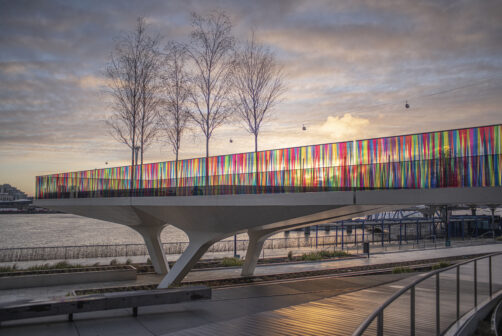
The Tide, wrapped in colour by artist Liz West, and with the Emirates Air Line cable car crossing the Thames behind
The Tide, part of 48 acres (20 hectares) of new public space on the peninsula, is an elevated linear riverside walkway which will eventually wrap 3 miles (5 kms) around the peninsula, towards the direction of Woolwich.
The first one-kilometre section opened in 2019 as an art trail. Over this summer alone, it attracted 15,000 people. The glass balustrade is currently wrapped in undulating colour by artist Liz West. Other installations include works by such well-known artists as Damien Hirst and Antony Gormley.
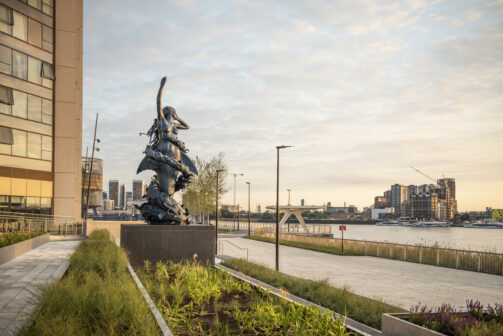
The Mermaid by Damien Hirst, part of the art trail at Greenwich Peninsula ©Charles Emerson
Over the pandemic lockdowns, the area provided much-needed open space, with its walkways, cycle lanes, viewpoints, barbecues and picnic spots. “Whole families would come out to have supper by the river,” says Sibson.
People need to make an elective choice to come here. They don’t come here by mistake. So, for us, placemaking becomes a critical part of the planning – Richard Margree
Three other initial steps to create a sense of place were the opening of: Greenwich Peninsula Golf Drive, where up to a million balls are teed off each month; Magazine London, a 3,000-person capacity events space; and The Jetty, a community hub on the river.
“Because we are almost an island, people need to make an elective choice to come here. They don’t come here by mistake. So, for us, placemaking becomes a critical part of the planning,” says Margree.
The Design District – an ecosystem for creatives
This autumn sees the opening of all four ‘quadrants’ of the Design District, which lies at the heart of Greenwich Peninsula, across Peninsula Square from North Greenwich tube station.
The Design District offers 150,000 sq ft (14,000 sq metres) of purpose-built space for 1,800 creatives in 16 buildings designed by eight internationally leading architects. All the buildings have been kept to three to four floors high – to maintain a human dimension – and connect via a honeycomb network of courtyards and alleyways.
Margree sees the Design District as a “beacon” for creatives, and for London – a globally known destination. It offers studios, workshops, office space (from a desk to a building), a private members’ club and a canteen, but in reality it offers much more – an ecosystem.
The Design District is starting to come to life, with a real mix across the creative industries – Kerri Sibson
The test of the Design District is the occupiers, says Margree. He refers to the “three-phase election”, when someone says: “I want to be in the Design District, as I get what these people are doing, and I think it’s fantastic; I want to be in that building by this architect, as I like the look of it; and, thirdly, I want to be next to these people as they are important in terms of my business ecosystem.”
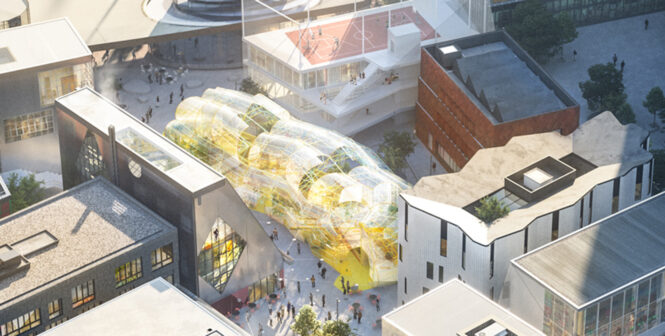
Buildings in the Design District clustered around The Canteen, designed by SelgasCano
As one leading London creative told MIPIM World: “This will be the first time London has a creative ecosystem”, adding, “even the air is different at Greenwich Peninsula. You can feel the river breezes. It’s very invigorating.”
Referring to London’s traditionally ‘cool’ districts of Shoreditch and Bermondsey, Margree says: “They weren’t cool, they were cheap. The creatives moved in and created a cool veneer, and then they ended up, ironically, being priced out.”
“The Design District is starting to come to life, with a real mix across the creative industries,” says Sibson. Those to have already moved in include architects, lighting designers, PR agencies, a creative and tech institute, as well as fashion and dance companies, and a craft social enterprise helping refugee women.
The architects turned up with a drawing and asked, ‘can we build that?’ And we said: ‘you’re going to build exactly that – Richard Margree
All 16 buildings were designed ‘blind’, with none of the architects knowing what each of them was designing. This has resulted in a “smorgasbord of brilliance” says Margree, who points out that human beings have always loved the slightly quirky, from little alleyways to buildings such as the Eiffel Tower.

Maintaining the Value of Your Real Estate in the Post-Pandemic World
Regarding the Design District, he says: “The architects turned up with a drawing and asked, ‘can we build that?’ And we said: ‘you’re going to build exactly that, and we’re not going to value engineer it or mess around with it or change your idea’.”
The 16 buildings include, for example:
- Ravensbourne University London’s Institute for Creativity & Technology: a flagship tenant in a building designed by Barcelona-based Barozzi Veiga, with its signature polished aluminium facade. (Greenwich Peninsula is also home to the main Ravensbourne campus.)
- Bureau: a private members’ club, together with co-working space, with an undulating shape creating informal pockets of space inside. The architect is London-based HNNA and the interiors are by Roz Barr Architects.

Private members’ club, Bureau, in the Design District
- Building D1: studios, workshops & office space designed by London-based Architect 00 – a concrete structure with tarnished gold-coloured window frames; ‘sociable’ external decks; a steel-mesh wrap, rather than balustrading; and a roof-top basketball court with views of the O2 Arena and Canary Wharf.
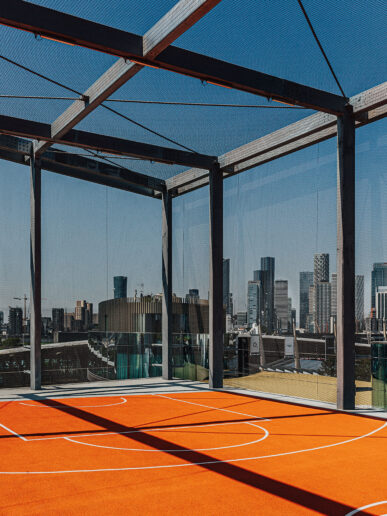
The view towards Canary Wharf from the Design District © Taran Wilkhu
- The Canteen: a transparent structure for eating, meeting and drinking, designed by Madrid-based architectural practice SelgasCano, also known for their 2015 Serpentine Pavilion in London. The Canteen is open to the public.
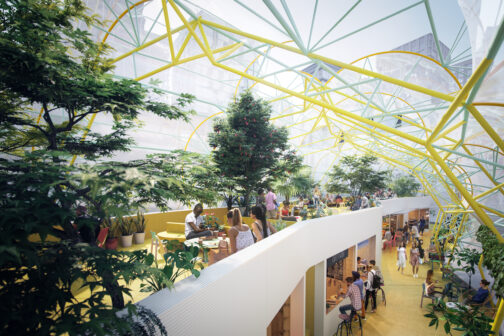
How to build a design district: take the “path of more resistance”
“We are not creating an investment to sell to a pension fund. The Design District is a permanent place for the creative industries. To put it bluntly, not many people would have done it, as it does not make sense on Day 1 [in terms of an investment],” says Margree, who also talks about the need for “bravery” to create a successful project at this scale.
Knight Dragon is creating a district that “makes sense” for the occupier – and the “right people” for the place, he adds. All 16 buildings are being developed at the same time. The average rent is £25 per sq ft, with an introductory £5 per sq ft across all spaces for the first year. “We did not want to turn it into a business park,” says Margree.
The path of least resistance would have been to build a big crinkly shed somewhere else on site – Margree, Knight Dragon
Margree continues: “The permanence of the Design District, and the size and nature of the buildings requires us to work a bit harder – to take the path of ‘more’ resistance,” although at times it has felt like ‘most’ resistance, he adds.
“The path of ‘least’ resistance would have been to build a big crinkly shed somewhere else on site – not right in the middle – and to wave our ‘look at us supporting the creative industries’ [flag].”
Greenwich Peninsula: the importance of thinking differently
“None of us, Kerri, myself, Sammy, Henry, went to traditional ‘development school’. I see that as a big strength for us, as it moves us away from the sort of group thinking you often get within an industry, particularly real estate” says Margree, who started his career as a lawyer.
If we jump on every momentary zeitgeist throwaway phrase we will get a pastiche of short termism, and that is not what we are about – Margree, Knight Dragon
“This is a 20-year scheme to create a whole new piece of city. If we jump on every momentary zeitgeist throwaway phrase, we will get a pastiche of short termism – and that is not what we are about,” he says.
In the early days, both Margree and Sibson said that they would have felt that they had failed if residents had left the peninsula at the weekends.
When MIPIM World visited the Peninsula one Saturday afternoon, the area was buzzing and there were plenty of residents at their windows watching the ballet dancers escalading down the mosaic-like tiled façade of the Ravensbourne University London building.
You cannot walk away from your mistakes here … This brings with it a strong sense of responsibility to create a sense of community and of place – Sibson, Knight Dragon
Sibson adds: “It’s not about tokenism – popping in a Waitrose, and you’ve made a place. As soon as we started working on the project, we realised that you cannot walk away from your mistakes here as they’re going to be there forever more. This brings with it a strong sense of responsibility to create a sense of community right from the beginning.”
Placemaking also requires flexibility of thought. For example, 33 is an outdoor three-storey wooden structure on a raised, concrete base. It was designed by Studio Weave as a modern folly, with views down the central park. Local residents decided it was also a roller-skating mecca.
“The community has taken over 33 for themselves. Our view is that if someone adopts something, even though we did not plan it at the very beginning, this is an absolute cast-iron indication that the community is beginning to be built,” says Margree.
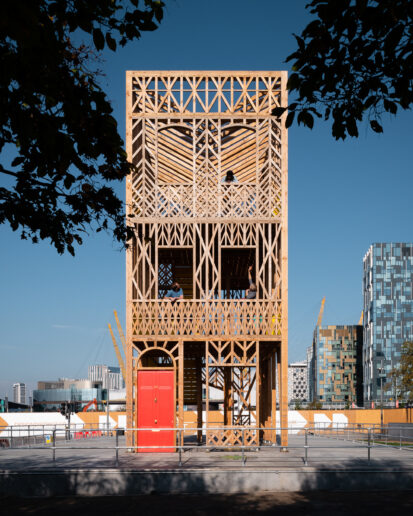
33 by Studio Weave. Copyright Jim Stephenson 2018
Summing up, Margree says: “It’s all about creating an interesting place. Otherwise, as a developer you’re just filling in some corporate pie chart that shows how much you’ve delivered that year.”
“Everyone lives where they live for a reason, whether for the transport, the schools or the open spaces. It is unlikely to be because of the en-suite bathroom,” adds Sibson. And yes, Greenwich Peninsula does offer new schools – two of them, as well as good transport and plenty of open spaces.
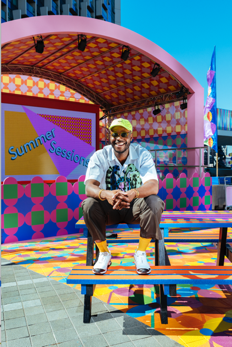
Artist Yinka Ilori bringing colour to Greenwich Peninsula this summer
